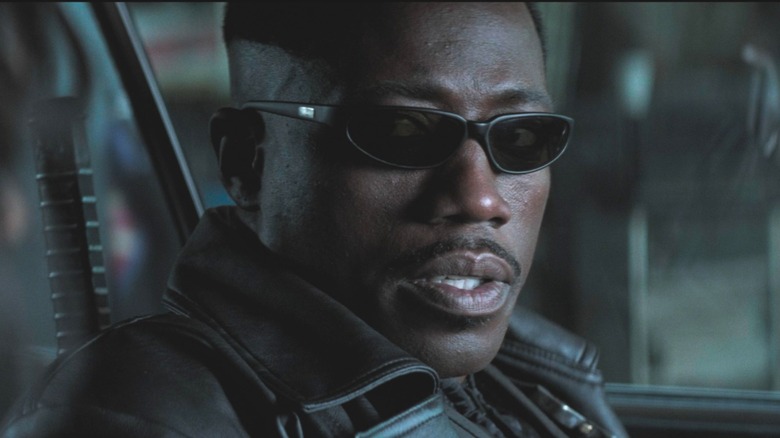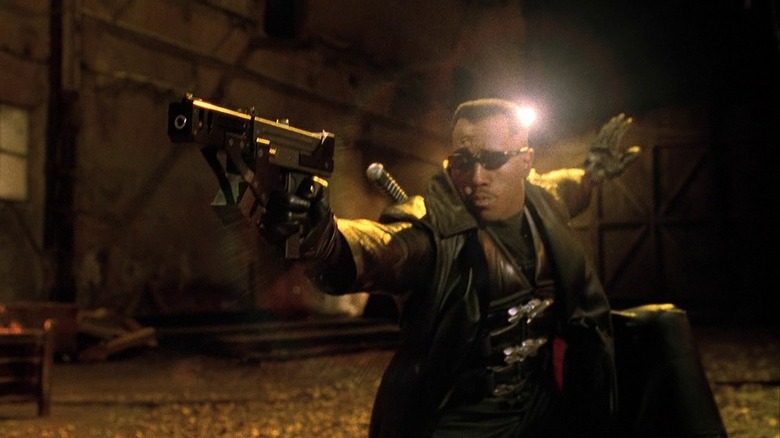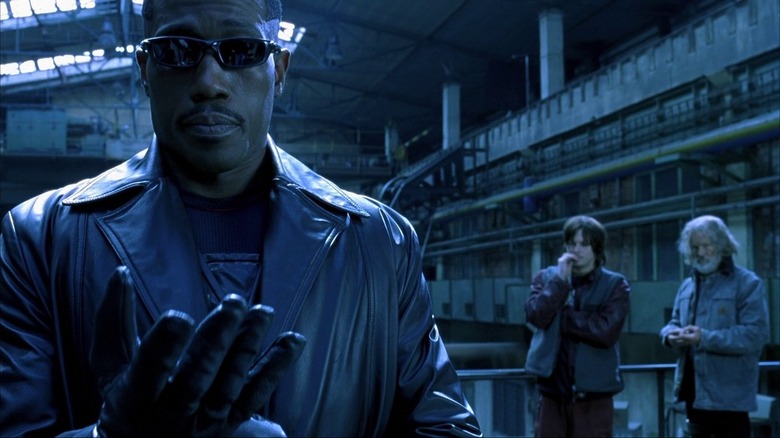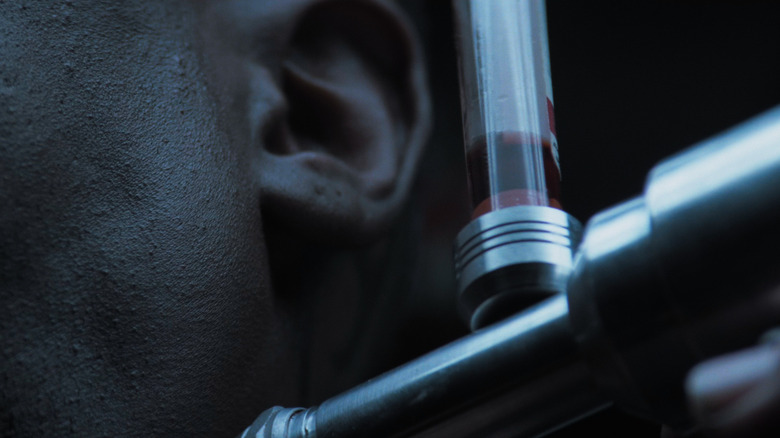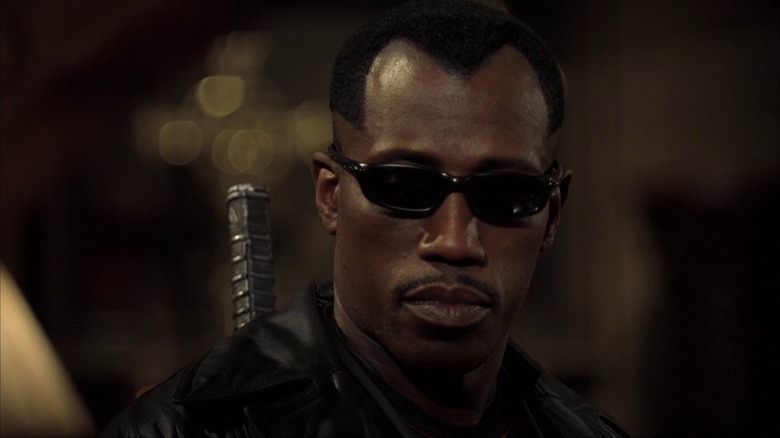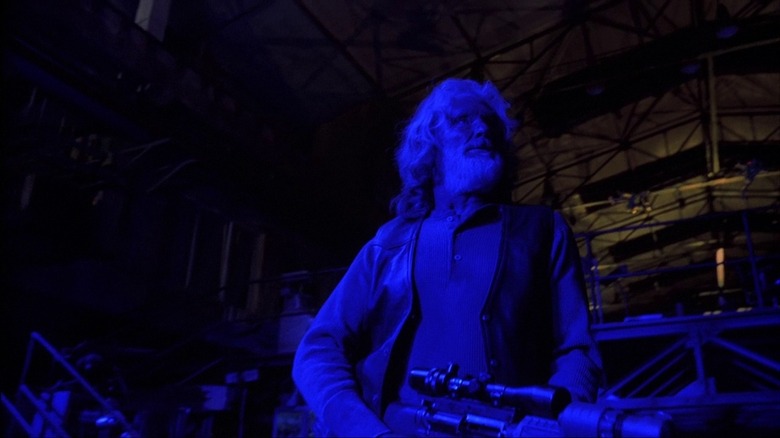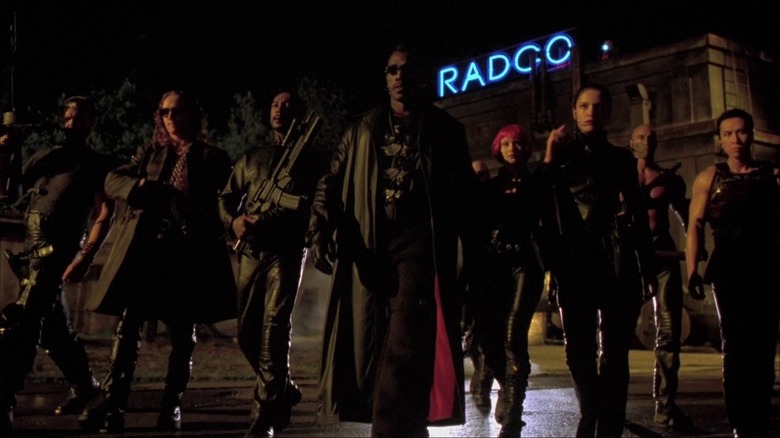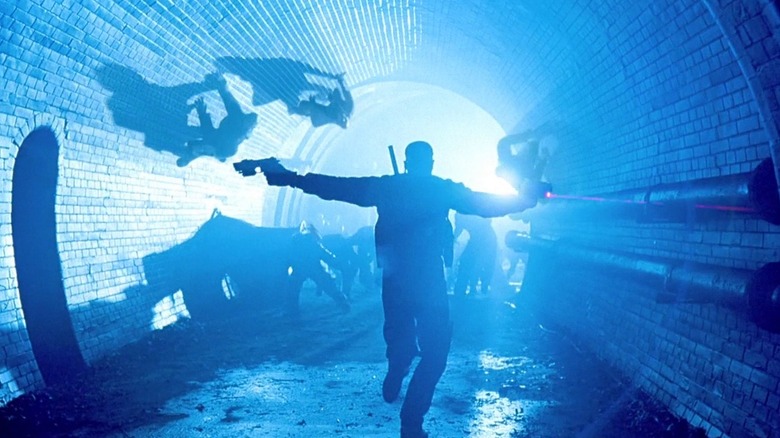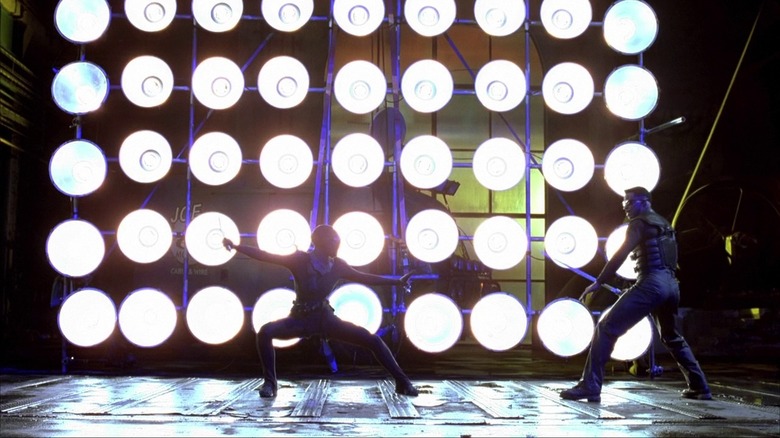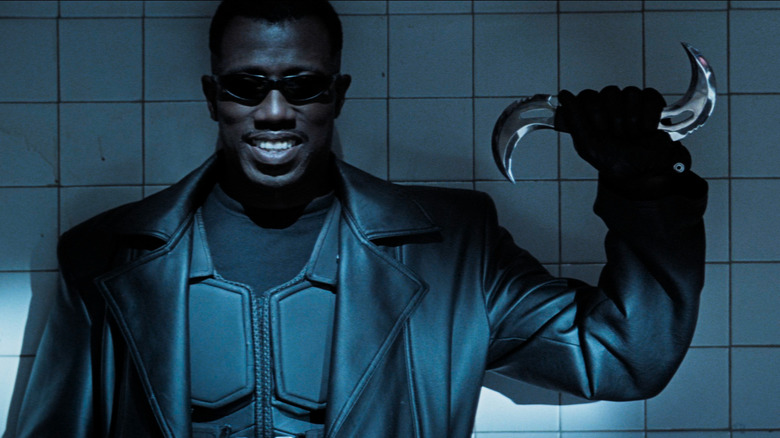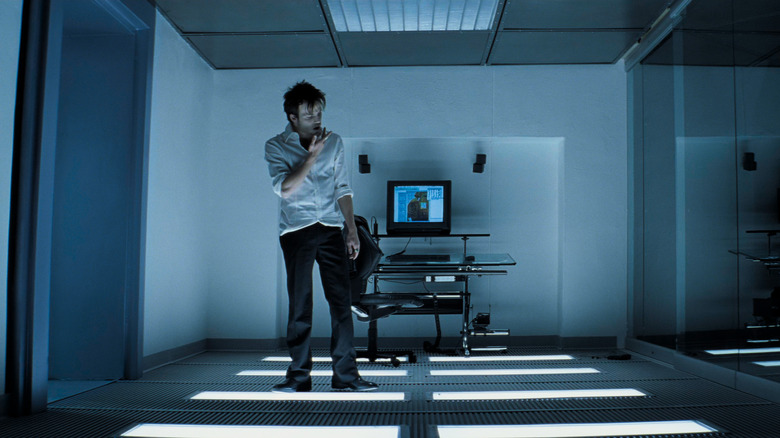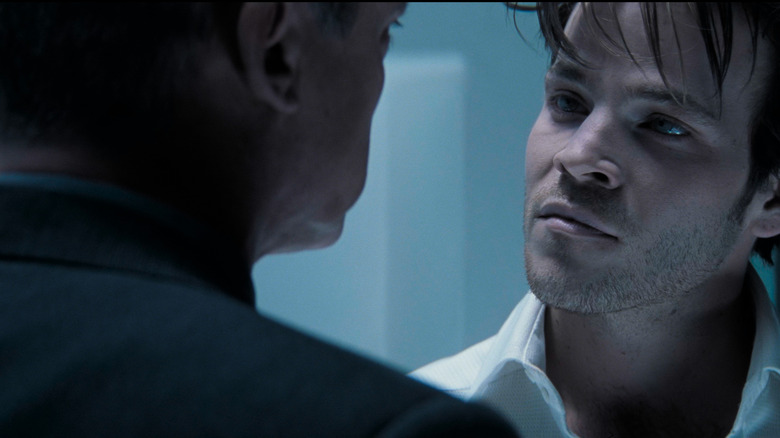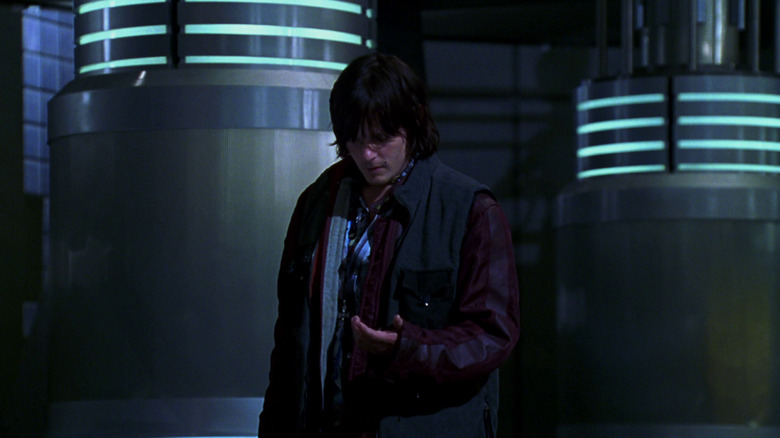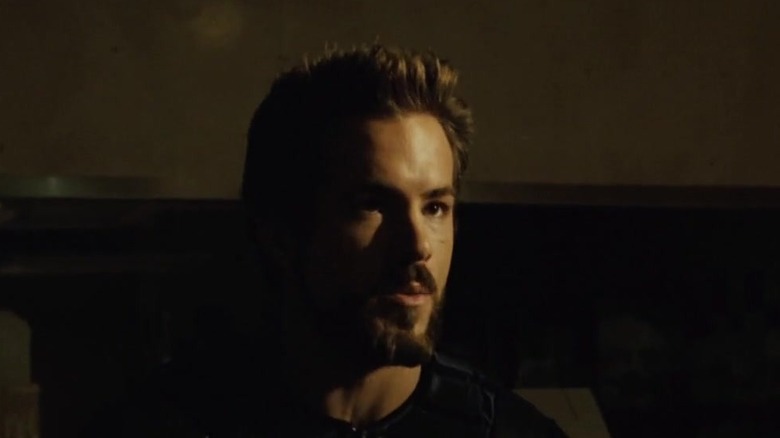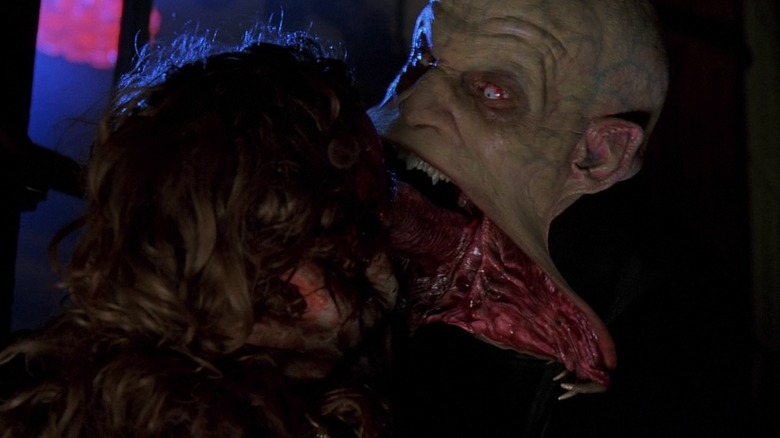Things That Happen In Every Blade Movie
1998's "Blade" introduced audiences to the world's coolest daywalker, portrayed by Wesley Snipes. Upon release, "Blade" had fantastic box office numbers and proved to studio executives that comic book movies rendered seriously resulted in success. Given the film's warm reception, "Blade" received a greenlit for a sequel — spawning a beloved franchise.
The subsequent "Blade" films all shine in unique ways. "Blade 2" features amazing character design and direction from the maestro of monsters Guillermo del Toro. "Blade Trinity" is a movie that's so odd it's entertaining, featuring an early action hero role from Ryan Reynolds. The actors' take on vampire hunter Hannibal King plays like an early template for his iconic turn as Deadpool.
Fans are looking forward to the character joining the Marvel Cinematic Universe — even though it faced some production hiccups — the latest entry appears to be currently in the works. Given the love for the character and his existing franchise, here we explore the things that happen in every Blade movie.
Impressive introductions
Marvel's Blade debuted in "Tomb of Dracula #10" in 1973. While some of his traits are present in his initial comic appearance — mainly his icy demeanor and general hatred for all things vampire — his image as a katana-wielding daywalker would take years to develop and evolve.
However, the folks behind the initial "Blade" likely assumed most audience members were unaware of his unique history. So instead of using a voice-over or exposition to explain who and what Blade is, director Stephen Norrington opens his 1998 film with one of the greatest opening throwdowns committed to the silver screen.
After a human stumbles into an underground vampiric rave by a leather-clad model (not your grandpa's Dracula story, folks!), Blade crashes the party and obliterates them. In a matter of minutes, the movie delivers all the information the audience needs to know about its universe. Vampires are bad. The movie's leveraging a gritty '90s aesthetic. Most importantly, Blade scares the vampires as much as they scare humans. The sequence is so good that it still comes up in culture columns some 20-odd years later, and built a template for later film entries to follow. So when Blade arrives on the scene in his later films, he always comes in guns blazing.
Warehouse hideouts
Where does a vampire-hunting daywalker rest his head? A grungy, '90s-era, and dangerous warehouse hideout, of course! Every "Blade" features the sword swinger's personal Batcave.
Since Blade's ongoing war with the brutal bloodsuckers remains hidden from the public, he and his dependable sidekick Whistler (Kris Kristofferson), often find themselves shacked up in an undesirable part of town — like an abandoned warehouse or shipyard. Whistler's the keeper of the castle and monopolizes most of the space to build all of Blade's fantastical, bone-splitting gear and weapons. However, their home base doesn't seem to have the tightest security. In every movie, it's basically attacked and or broken into by vamps or authorities.
In "Blade Trinity," the FBI raids Blade's hideout and Whistler triggers its self-destruct mechanism. In the first film, evil vampire Frost (Stephen Dorff) and his goons seemingly stroll right into the place! While Blade's impromptu home is no Fortress of Solitude, no entry within the franchise is complete without a quick stop at Blade's humble (but likely about to be destroyed) abode.
The thirst
Blade, whose real name (in comic continuity) is Eric Brooks, is a unique type of vampiric monster known as a daywalker — essentially, he's half-human and half-vampire. His vampiric half gives him super strength, nigh-immortality, and durability. His human half enables Blade to venture out into the sunlight. It's almost a "Hannah Montana" or best-of-both-worlds situation for Blade. However, he still needs to feed on human blood or he'll get weak.
In each film, Blade contends with his desire to munch on the folks he's trying to protect. Obviously, it's not easy, and each movie finds a new way to keep Blade's hunger contained. However, the first film in the franchise keeps Blade's desire to feed as a secondary plot to the central conflict. This choice helps give Blade character, following his almost "Terminator"-like debut on-screen. Without watching Blade fight the urge to feed, the audience is basically watching Snipes mow through leather-clad baddies for an entire movie. Giving Blade an internal conflict reveals his human side and gives Snipes more to do than scowl, quip, and kick. For the record, he may be the best at all those things.
The Daywalker
Blade's ability to go to the beach or on a hike makes him a huge threat to vampires everywhere. The guy not only knows all their secrets but can literally go places during times they can't. He's their boogeyman, kaiju, and the Shark from "Jaws" all rolled into one. (Good thing he's on humanity's side!)
Given Blade's reputation and stigma in the vampire community, most vamps only refer to Blade as "Daywalker" or "The Daywalker." The term gets said in anger, fear, resentment, and sometimes even shouted in peer rage. As an example, here's actor Luke Goss as cannibalistic vampire Jared Nomak deliciously delivering the famous line.
Interestingly, Blade's daywalker status wasn't always a part of his presence in Marvel comics. The full story behind Blade's transformation into a Daywalker wasn't put on the page until 1998's Peter Parker: Spider-Man #8 (via GamesRadar). While Blade's movie history differs from his comic-book history (the movie doesn't include Morbius for example), it's interesting to consider how much the franchise made the phrase "Daywalker" part of Blade's mythos.
Whistler's in trouble
Whistler — Blade's mentor, father figure, and partner — is a franchise staple. The vampire hunter taught Blade everything about hunting vampires. Plus, he's played with grizzled authority by country music legend Kris Kristofferson. (The guy's practically Hollywood royalty and played the male lead alongside Barbara Streisand in 1976's "A Star is Born.") When he's not arming Blade to the teeth, he's throwing down with vampires himself.
Since he's the only human Blade has any connection with, he's constantly in danger. In the first movie — spoiler — it's suggested to the audience that Whistler dies during a vampiric raid on Blade's safe house. In "Blade II," Blade discovers Whistler's alive but worries he may have turned into a vampire. In "Blade: Trinity," Whistler dies when the FBI raids their safe house.
Unlike other parts of Blade's lore, Whistler was not from the comics: Blade franchise screenwriter David S. Goyer created the character. In the comics, Blade's mentor is a Black jazz player named Jamal Afari. While Whistler is a staple of the original Blade film franchise, he likely won't appear in the upcoming MCU film. Reportedly, Delroy Lindo will play Afari in "Blade" (via The Hollywood Reporter).
New teammates
In each iteration of Blade's story, Blade teams up and works with likely and unlikely allies. In the first film, Blade fights alongside Whistler and Dr. Karen Jenson (N'Bushe Wright), a hematologist. In "Blade II," Blade teams up with the Bloodpack, an elite group of vampiric commandos, to take down a more dangerous variant of vampires called The Reapers. The catch? The Bloodpack originally trained to hunt Blade himself. Their begrudging alliance is a big part of what makes del Toro's "Blade II" so fun. Finally, in the third film, Blade teams up with the Night Stalkers, a group of vampire hunters led by Hannibal King and Whistler's daughter, Abigail (Jessica Biel). Hannibal and Abigail bring levity to a movie that was too bloated for its own good.
The "Blade" films were never above winking at the audience. Largely, their charms come from watching different folks bounce off of Blade and his intense brooding. In a way, it's similar to the straight man-funny man comedic pairing — only the straight man is a sword-wielding monster hunter in wrap-around shades and a trench coat.
Epic one-liners
Fans know that Blade is not one for chit-chat or small talk. But when he chooses to speak, he delivers some pretty fantastically ludicrous dialogue. His greatest hits include, but are not limited to, "Some mother******* are always trying to ice skate uphill." Or, "You obviously do not know who you are f****** with!"
A lot of Blade's onscreen personality stems from Goyer's understanding of Snipes' unique charisma. Goyer wrote Blade with Snipes' voice and fashion sense (via The Hollywood Reporter) in mind. It may be hard for modern moviegoers accustomed to MCU's spectacle to imagine, but Snipes had the necessary X-factor to sell Blade's outlandish quips and tactical leather uniform to an audience. In other words: Without Snipes, there is no Blade.
While Blade's quips aren't particularly family-friendly, they certainly place him in a tier of one-liner delivery with the likes of James Bond and John McClane.
MMA
When Blade isn't tossing all sorts of silver and garlic-based weapons at his enemies, he's giving them an old-fashioned set of flying fists and kicks that would make Bruce Lee proud. While Blade wasn't always associated with martial arts in the comics, Snipes has. The action star is a five-time black belt (via Den of Geek). Snipes' incorporation of combat knowledge into the character solidified the character's strength.
In an interview promoting his comic book "The Exiled," Snipes told ComicBookMovie.com that the inspiration for making Blade was to create a movie that fans of "kung fu" and "Shaft" movies would enjoy. Given the initial movie spun out into a franchise, it's safe to say Snipes was on to something by aiming for those distinct fan groups.
It's a good thing Snipes' intuition paid off because the fight choreography in the "Blade" franchise is phenomenal. The highlight of the series comes in "Blade 2" when the vampire hunter fends off two members of the Bloodpack. The sword fight features incredible lighting, killer footwork from Snipes, and the sense that Blade is as cool as a cucumber during a duel as he is in everyday life. Dated CGI aside, it's a throwdown that still holds up and represents what makes the franchise so fun.
Blades, blades, and more blades!
No vampire hunter can journey into the field without the tools of his trade, and Blade's no exception to the rule. Every entry in the "Blade" franchise features a scene of the titular vampire hunter gearing up with new toys, courtesy of Whistler. While the vigilante's sword is his iconic weapon, he uses everything from stakes to automatic pistols to UV grenades with crucifix pins. That's really only the tip of the iceberg.
Since the franchise is named after our hero's weapon of choice, this one might feel like a cheat to add in here. However, no entry in the "Blade" cannon is complete without multiple close-ups and crash zooms of the Daywalker's distinctive weaponry. Even Snipes agrees! In an interview about his time as Blade, Snipes revealed he still has some of the original prop swords built for production. He vaguely suggests he may still use them to train. Here's hoping that Snipes gets to put his training to good use in the next iteration of "Blade."
Vampire MacGuffins
Every story — especially a story based on a comic — needs a reason to put its hero in direct (often violent) conflict with its villains. Yes, each film pits Blade against vampires. But to make the stories more interesting than that setup, each film entry gives its bloodsucking baddies a MacGuffin, a random item or object to drive the plot without being enormously consequential.
In "Blade Trinity," the high vampiric order attempts to use Blade's blood to reanimate Dracula. In the first film, the villainous Frost wants to usurp power from the vampire elders by summoning a blood god called La Magra.
Is it a tad ridiculous? Oh, absolutely! But these movies are — as Snipes put it previously — "Shaft" meets Marvel's resident vampire hunter. A bit of wacky plot development only enhances the fun. Critic Roger Ebert summed it up expertly in his review of 1998's "Blade," stating that it "slams ahead in pure visceral imagery."
Bad guy infighting
But quests for ancient vampire relics or cures for a severe Vitamin-D allergy aren't the only things that make the franchise's fanged villains so compelling. What sets the baddies in the world of Blade apart from other evildoers is their constant infighting.
During every movie, sooner or later, one group of vampires turns on another. In the case of "Blade 2," the Reaper vampires — made distinct by their bizarre and loosely based on animal adaptations design — hunt their non-Reaper counterparts. This choice helps add more complications to who is the hunter and hunted. Plus, it makes Blade's foes nuanced characters.
Giving Blade's enemies distinct (if sometimes blurry) goals enables the audience to see different sides of the human feeders and the Daywalker. Goyer believes good writing comes from allowing characters to be fully human and he applies that well to the vampires' mythos in "Blade" (via ThatShelf.com).
Familiars mess everything up
Familiars — humans who live to serve vampires — have existed in vampiric lore since the beginning. Dracula has Reinfeld (who's reportedly getting a film) and Stephen King's "Salem's Lot" has Richard Straker. In the "Blade" universe, familiars wear the brands of the vampiric masters — like cattle. Generally, they annoy, betray, and harass the Daywalker at every turn.
The worst of the familiars is Scud (yes, seriously, that's his name) from "Blade II." Scud, as played by "The Walking Dead" star Norman Reedus, is initially Blade's ally. He's even filled in for Whistler while Whistler was held in vampiric captivity and became Blade's weapons guy.
However, in the movie's final act, Scud reveals he's been a familiar for the entire time he's known Blade. Briefly, it seems like Scud got the best of the Daywalker. But Blade soon tells him he's been on to him the whole time and promptly blows him up. Yes, it's fantastically silly, but it's another reason the "Blade" franchise remains entertaining.
Hysterical co-stars
The "Blade" franchise features a laundry list of interesting actors. First-time viewers may be surprised at who appears in each film — like when martial arts legend Donnie Yen appears in "Blade II." Other supporting cast members include character actors like Stephen Dorff and Parker Posey as villains and instantly recognizable faces like Ron Pearlman. If that weren't enough, Ryan Reynolds, Jessica Biel, and actor-comedian Patton Oswalt all play members of the Night Stalkers in "Blade Trinity."
Reynolds gives a stand-out performance as the wise-cracking monster hunter Hannibal King. Reynolds quips, jokes, and walks away with every scene he's in, which balances well against Snipes' cynical line delivery.
Given that the next "Blade" takes place in the MCU, there should be no shortage of interesting supporting characters. Hopefully, Blade links up with the stars of "Werewolf by Night," Jack Russell, and Ted (aka Man-Thing), as he did in the comics when he was a part of the Midnight Suns group.
Gorrific action
Last but certainly not least, let's talk about the franchise's gore factor. Every movie in the "Blade" franchise features a wide range of bloodshed, sunlight-induced vampiric combustion, explosions, feeding, and splatter. Gore is an essential part of what makes the "Blade" movies so enjoyable. In his review of "Blade II," Ebert described the film as a "rather brilliant vomitorium of viscera, a comic book with dreams of becoming a textbook for mad surgeons." For horror fans, it really is entertaining to behold.
Plus, the late '90s and early 2000s computer-generated special effects have aged into something past looking fake: The effects now radiate off the screen with a certain degree of nostalgic charm. What might've been shockingly realistic in 1998 plays now like a campy time capsule.
Critics even credit "Blade" for putting the "bullet time" (see: slow-motion gun fights) on screen before the Wachowskis Sisters coined the term with their iconic sequences in "The Matrix" the following year (via The Hollywood Reporter). If slapstick gore and "pre-Matrix" bullet time aren't enough to convince action or horror fans to check out a "Blade" movie, maybe nothing is. Genre fans should do themselves a favor and seek out these films. Happy hunting, daywalkers.
